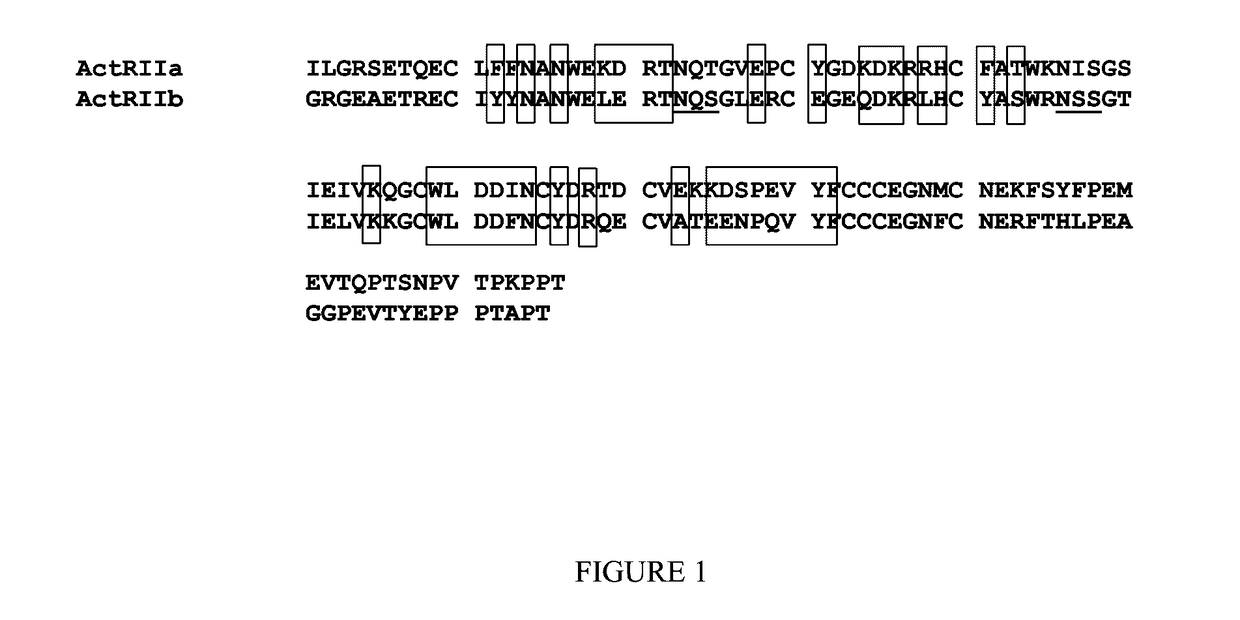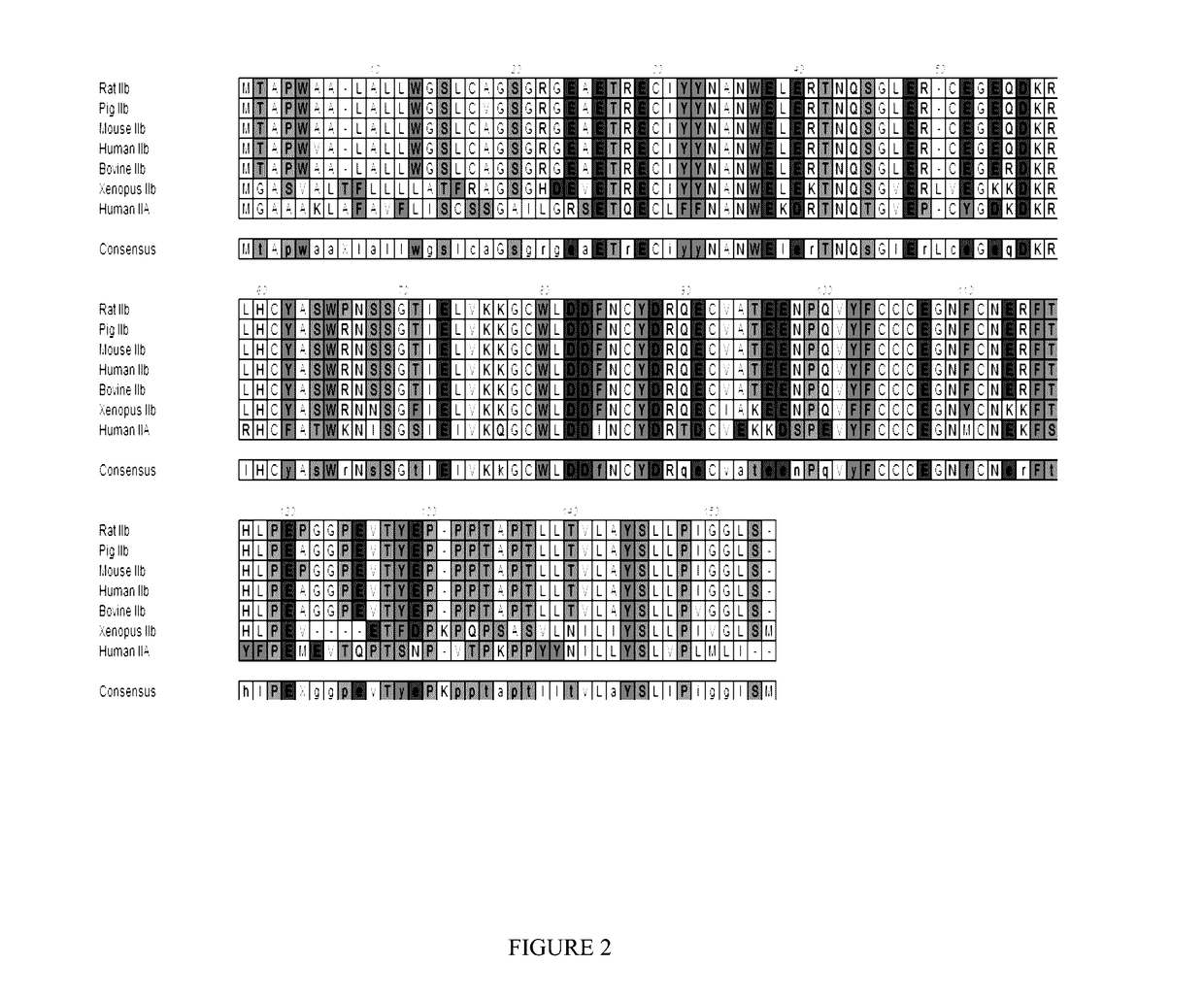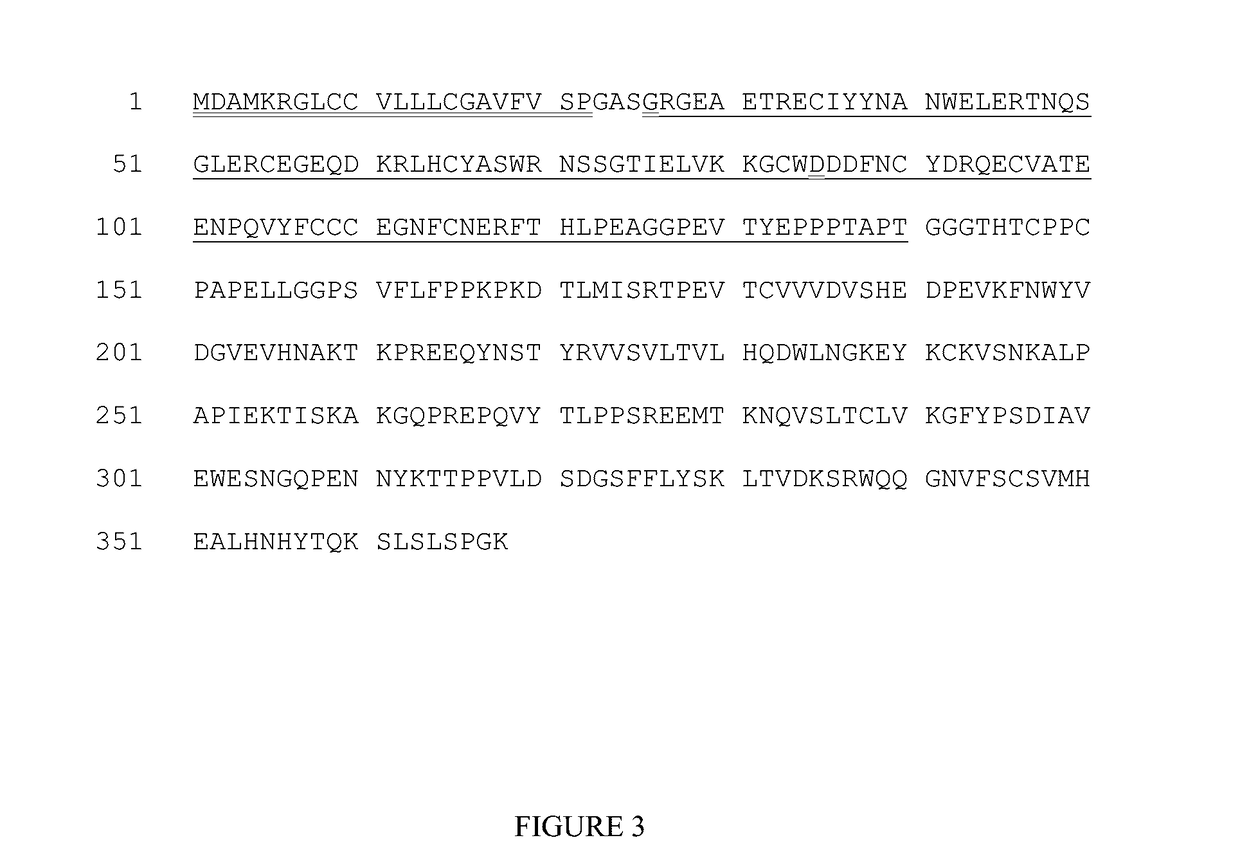[0010]In part, the disclosure demonstrates that GDF Traps may be used to treat ineffective erythropoiesis and the disorders and symptoms that are associated with ineffective erythropoiesis, including, without limitation, anemia, splenomegaly, iron overload, hypercellular bone marrow, elevated endogenous erythropoietin levels and bone damage. In particular, the disclosure demonstrates that a GDF Trap which is a soluble form of ActRIIB polypeptide having an acidic residue at position 79 of SEQ ID NO: 1, when administered in vivo, increases red blood cell levels in the blood in normal, healthy subjects as well as animal models of anemia and ineffective erythropoiesis. Surprisingly, in addition to directly increasing red blood cell levels, the disclosed molecules ameliorate other symptoms associated with ineffective erythropoiesis, including splenomegaly, iron overload and bone damage. In some instances, these associated disorders are of equal or greater importance to patient health and quality of life as the anemic condition. Therefore, in certain embodiments, the disclosure provides methods for using GDF Traps to increase red blood cell and hemoglobin levels in patients and to treat disorders associated with low red blood cell levels in patients in need thereof. In particular, the disclosure provides methods for using GDF Trap polypeptides to treat complications arising from disorders of ineffective erythropoiesis, including such major complications as anemia, tissue iron overload, extramedullary erythropoiesis, erythroblast-induced bone pathology, and inappropriately elevated erythropoietin levels. In such disorders, GDF Traps can be used to increase red blood cell levels while reducing the need for red blood cell transfusions and iron chelation therapy, and to thereby reduce morbidity and mortality associated with iron accumulation in vulnerable tissues. In part, a GDF Trap can be used in combination with existing supportive therapies for ineffective erythropoiesis, including transfusion of red blood cells and iron chelation therapy. GDF Traps can also be used in combination with a hepcidin agonist to treat ineffective erythropoiesis. As described in U.S. patent application Ser. No. 12 / 012,652, incorporated by reference herein, GDF Traps may also be used to increase muscle mass and decrease fat mass.
[0014]A GDF Trap may be a fusion protein that has, as one domain, an ActRIIB polypeptide (e.g., a ligand-binding domain of an ActRIIB with one or more sequence variations) and one or more additional domains that provide a desirable property, such as improved pharmacokinetics, easier purification, targeting to particular tissues, etc. For example, a domain of a fusion protein may enhance one or more of in vivo stability, in vivo half life, uptake / administration, tissue localization or distribution, formation of protein complexes, multimerization of the fusion protein, and / or purification. GDF Trap fusion proteins may include an immunoglobulin Fc domain (wild-type or mutant) or a serum albumin. In certain embodiments, a GDF Trap fusion comprises a relatively unstructured linker positioned between the Fc domain and the extracellular ActRIIB domain. This unstructured linker may correspond to the roughly 15 amino acid unstructured region at the C-terminal end of the extracellular domain of ActRIIB (the “tail”), or it may be an artificial sequence of between 3 and 5, 15, 20, 30, 50 or more amino acids that are relatively free of secondary structure. A linker may be rich in glycine and proline residues and may, for example, contain repeating sequences of threonine / serine and glycines (e.g., TG4 (SEQ ID NO: 13) or SG4 (SEQ ID NO: 14) singlets or repeats) or a series of three glycines. A fusion protein may include a purification subsequence, such as an epitope tag, a FLAG tag, a polyhistidine sequence, and a GST fusion. In certain embodiments, a GDF Trap fusion comprises a leader sequence. The leader sequence may be a native ActRIIB leader sequence or a heterologous leader sequence. In certain embodiments, the leader sequence is a Tissue Plasminogen Activator (TPA) leader sequence. In an embodiment, a GDF Trap fusion protein comprises an amino acid sequence as set forth in the formula A-B-C. The B portion is an N- and C-terminally truncated ActRIIB polypeptide consisting of the amino acid sequence corresponding to amino acids 25-131 of SEQ ID NO: 2 or 40. The A and C portions may be independently zero, one or more than one amino acids, and both A and C portions are heterologous to B. The A and / or C portions may be attached to the B portion via a linker sequence.
[0015]Optionally, a GDF Trap includes a variant ActRIIB polypeptide having one or more modified amino acid residues selected from: a glycosylated amino acid, a PEGylated amino acid, a farnesylated amino acid, an acetylated amino acid, a biotinylated amino acid, an amino acid conjugated to a lipid moiety, and an amino acid conjugated to an organic derivatizing agent. A pharmaceutical preparation may also include one or more additional compounds such as a compound that is used to treat an ActRIIB-associated disorder. Preferably, a pharmaceutical preparation is substantially pyrogen free. In general, it is preferable that a GDF Trap be expressed in a mammalian cell line that mediates suitably natural glycosylation of the GDF Trap so as to diminish the likelihood of an unfavorable immune response in a patient. Human and CHO cell lines have been used successfully, and it is expected that other common mammalian expression vectors will be useful.
[0017]In certain aspects, the disclosure provides GDF Traps which are soluble ActRIIB polypeptides comprising an altered ligand-binding (e.g., GDF8-binding) domain. GDF Traps with altered ligand-binding domains may comprise, for example, one or more mutations at amino acid residues such as E37, E39, R40, K55, R56, Y60, A64, K74, W78, L79, D80, F82 and F101 of human ActRIIB (numbering is relative to SEQ ID NO: 1). Optionally, the altered ligand-binding domain can have increased selectivity for a ligand such as GDF8 / GDF11 relative to a wild-type ligand-binding domain of an ActRIIB receptor. To illustrate, these mutations are demonstrated herein to increase the selectivity of the altered ligand-binding domain for GDF11 (and therefore, presumably, GDF8) over activin: K74Y, K74F, K74I, L79D, L79E, and D801. The following mutations have the reverse effect, increasing the ratio of activin binding over GDF11: D54A, K55A, L79A and F82A. The overall (GDF11 and activin) binding activity can be increased by inclusion of the “tail” region or, presumably, an unstructured linker region, and also by use of a K74A mutation. Other mutations that caused an overall decrease in ligand binding affinity, include: R40A, E37A, R56A, W78A, D80K, D80R, D80A, D80G, D80F, D80M and D80N. Mutations may be combined to achieve desired effects. For example, many of the mutations that affect the ratio of GDF11:Activin binding have an overall negative effect on ligand binding, and therefore, these may be combined with mutations that generally increase ligand binding to produce an improved binding protein with ligand selectivity. In an exemplary embodiment, a GDF Trap is an ActRIIB polypeptide comprising an L79D or L79E mutation, optionally in combination with additional amino acid substitutions, additions or deletions.
[0025]In part, the disclosure demonstrates that GDF Traps may be used in combination (e.g., administered at the same time or different times, but generally in such a manner as to achieve overlapping pharmacological effects) with EPO receptor activators to increase red blood cell levels (erythropoiesis) or treat anemia in patients in need thereof. In part, the disclosure demonstrates that a GDF Trap can be administered in combination with an EPO receptor activator to synergistically increase formation of red blood cells in a patient. Thus, the effect of this combined treatment can be significantly greater than the sum of the effects of the GDF Trap and the EPO receptor activator when administered separately at their respective doses. In certain embodiments, this synergism may be advantageous since it enables target levels of red blood cells to be attained with lower doses of an EPO receptor activator, thereby avoiding potential adverse effects or other problems associated with higher levels of EPO receptor activation.
[0028]In certain aspects, the disclosure provides methods for administering a GDF Trap polypeptide to a patient. In part, the disclosure demonstrates that GDF Trap polypeptides can be used to increase red blood cell and hemoglobin levels. In part, the disclosure demonstrates that GDF Trap polypeptides can be used to treat patients with ineffective erythropoiesis and to reduce one or more conditions associated with ineffective erythropoiesis, such as anemia, splenomegaly, iron overload or bony disorders. In certain aspects, the disclosure provides methods for using GDF Trap polypeptides to treat ineffective erythropoiesis in a patient with thalassemia while reducing the need for transfusion of red blood cells and reducing morbidity and mortality associated with iron deposition in vulnerable tissues. In particular, a GDF Trap polypeptide can be used in this way to treat β-thalassemia syndromes, including β-thalassemia intermedia. GDF Trap polypeptides may also be used for treating or preventing other therapeutic uses such as promoting muscle growth. In certain instances, when administering a GDF Trap polypeptide for promoting muscle growth, it may be desirable to monitor the effects on red blood cells during administration of the GDF Trap polypeptide, or to determine or adjust the dosing of the GDF Trap polypeptide, in order to reduce undesired effects on red blood cells. For example, increases in red blood cell levels, hemoglobin levels, or hematocrit levels may cause increases in blood pressure.
 Login to View More
Login to View More 


